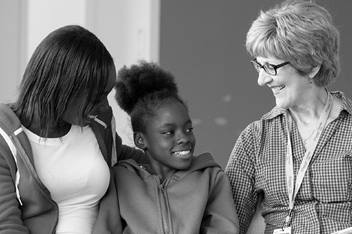Supplemental Security Income: Linking Families With This Crucial But Underused Resource
Decades of research show that children who live in poverty have worse lifetime outcomes and prospects than other children; in fact, poverty can cause poor health.
That’s compounded when a child living in poverty also has a disability. A child with a disability can require an enormous amount of care. Some need it around-the-clock. Parents may be unable to work because of a child’s condition, making it impossible for the family to rise out of poverty.
The federal program known as Supplemental Security Income (SSI) can help, but only when families know about it and make it through the complicated, lengthy application process. In Ohio alone, reliable estimates indicate many thousands – perhaps tens of thousands – of children and families who are eligible for this money do not receive it.
Nationwide Children’s Hospital and its accountable care organization, Partners For Kids, are now implementing strategies to help more of these families access SSI. In some cases, these are the same kinds of strategies that other providers could use to help their patients as well, especially large children’s hospitals providing most of the specialty care for these patients.

“We’re a natural partner for these children, because we already see so many of them in hospital and clinics for so many reasons,” says Rosemary Martoma, MD, a primary care pediatrician at Nationwide Children’s who is helping implement the hospital’s initiatives. “The families need these funds, and we can help them receive them.”
SSI is for people – often children and older adults – who are both disabled and living in poverty. In 2021, an individual can receive nearly $800 per month. Next year, the maximum for an individual will rise to $842 per month. That’s stable, predictable income in unstable family financial situations.
But some families do not know about it, and that’s just the first of many possible obstacles to enrollment. The application requires proof of income, a comprehensive assets review, a child functional assessment, and critical evaluation of disabling health conditions, which are often difficult to document and consolidate across providers and schools. Approval after application can take six months or longer.
Ohio’s Medicaid Managed Care plans have contracted with a health care technology and services company, Centauri Health Solutions, to help enroll eligible families in SSI. Centauri has identified at least 10,000 children who may qualify in south central, southeastern and west central Ohio alone.
But Nationwide Children’s has found, in a pilot program, that families do not always understand the company’s outreach attempts. Families living in poverty may also change phone numbers or addresses regularly, making them difficult to contact.
Nationwide Children’s and Partners For Kids are in a position to reduce many of these barriers, says Mary Siefke, CPA, director of Finance and Medical Economics for Partners For Kids. Partners For Kids is responsible for the health of more than 470,000 children in south central, southeastern and west central Ohio covered by Medicaid Managed Care.
The 10,000 potentially eligible for SSI are among them. Partners For Kids’ nurses and social workers have ongoing, direct relationships with some through its Care Navigation program. Partners For Kids also the ability to reach children through their primary care providers. And as Dr. Martoma notes, many of those children visit Nationwide Children’s for services, another opportunity to identify them and help connect them with SSI.
The children and families that Centauri has identified trust Nationwide Children’s and their other providers, so there’s reason to think this “warm” introduction to SSI will encourage more to apply. Partners For Kids has begun working with Centauri to make this possible.
Nationwide Children’s and Partners For Kids also intend to look at their own patient populations to determine if other children are eligible.
All of this will be a long process, says Siefke. But because of the impact it could make for children with disability who live in poverty, it’s important to start.
“There are so many children, and so many families, that SSI could ultimately help,” she says.



